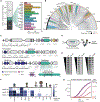Genome integrity sensing by the broad-spectrum Hachiman antiphage defense complex
- PMID: 39395413
- PMCID: PMC12278908
- DOI: 10.1016/j.cell.2024.09.020
Genome integrity sensing by the broad-spectrum Hachiman antiphage defense complex
Abstract
Hachiman is a broad-spectrum antiphage defense system of unknown function. We show here that Hachiman is a heterodimeric nuclease-helicase complex, HamAB. HamA, previously a protein of unknown function, is the effector nuclease. HamB is the sensor helicase. HamB constrains HamA activity during surveillance of intact double-stranded DNA (dsDNA). When the HamAB complex detects DNA damage, HamB helicase activity activates HamA, unleashing nuclease activity. Hachiman activation degrades all DNA in the cell, creating "phantom" cells devoid of both phage and host DNA. We demonstrate Hachiman activation in the absence of phage by treatment with DNA-damaging agents, suggesting that Hachiman responds to aberrant DNA states. Phylogenetic similarities between the Hachiman helicase and enzymes from eukaryotes and archaea suggest deep functional symmetries with other important helicases across domains of life.
Keywords: cryo-EM; genome integrity; helicase; immunity; phage defense.
Copyright © 2024 The Author(s). Published by Elsevier Inc. All rights reserved.
Conflict of interest statement
Declaration of interests The Regents of the University of California have patents issued and pending for CRISPR technologies on which J.A.D. is an inventor. J.A.D. is a co-founder of Azalea Therapeutics, Caribou Biosciences, Editas Medicine, Evercrisp, Scribe Therapeutics, Intellia Therapeutics, and Mammoth Biosciences. J.A.D. is a scientific advisory board member at Evercrisp, Caribou Biosciences, Intellia Therapeutics, Scribe Therapeutics, Mammoth Biosciences, The Column Group, and Inari. She also is an advisor for Aditum Bio. J.A.D. is Chief Science Advisor to Sixth Street; a Director at Johnson & Johnson, Altos, and Tempus; and has a research project sponsored by Apple Tree Partners. J.P. has an equity interest in Linnaeus Bioscience Incorporated and receives income. The terms of this arrangement have been reviewed and approved by the University of California, San Diego, in accordance with its conflict-of-interest policies.
Figures







Update of
-
Hachiman is a genome integrity sensor.bioRxiv [Preprint]. 2024 Feb 29:2024.02.29.582594. doi: 10.1101/2024.02.29.582594. bioRxiv. 2024. Update in: Cell. 2024 Nov 27;187(24):6914-6928.e20. doi: 10.1016/j.cell.2024.09.020. PMID: 38464307 Free PMC article. Updated. Preprint.

